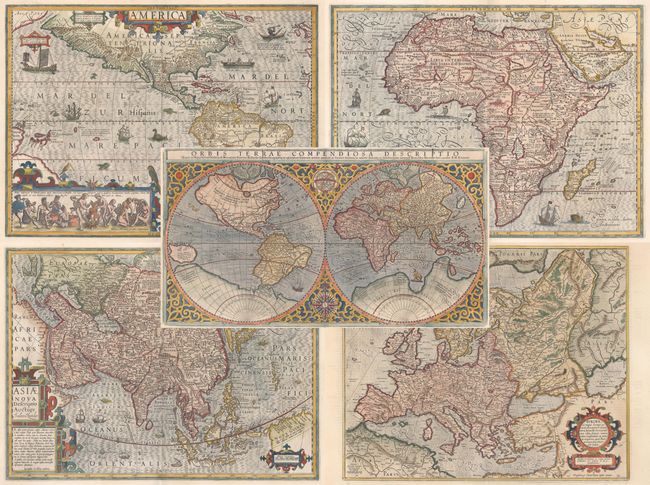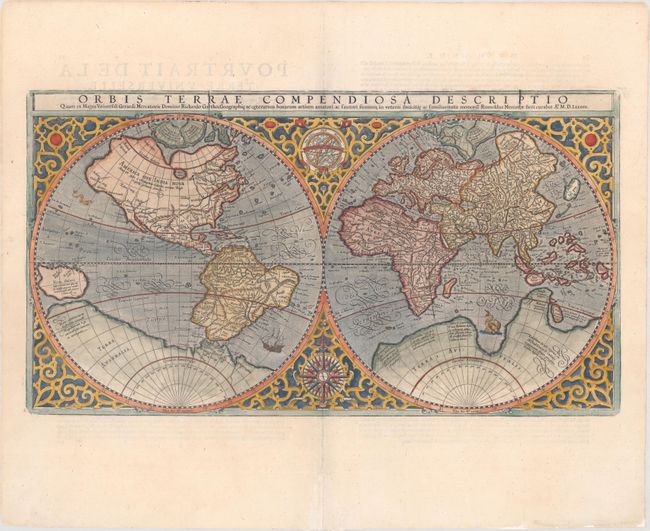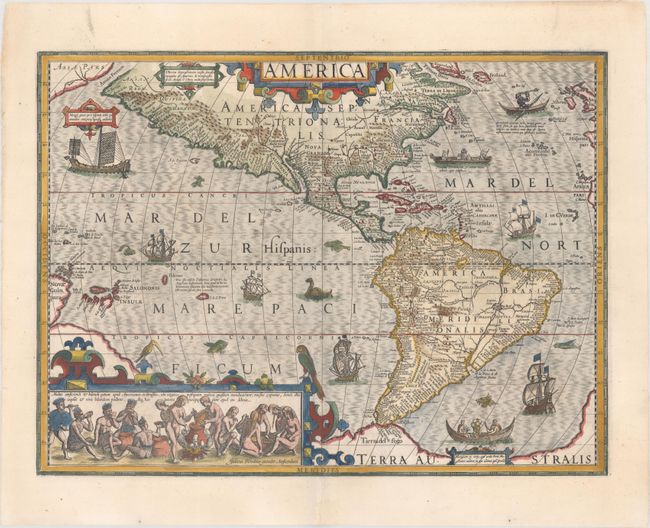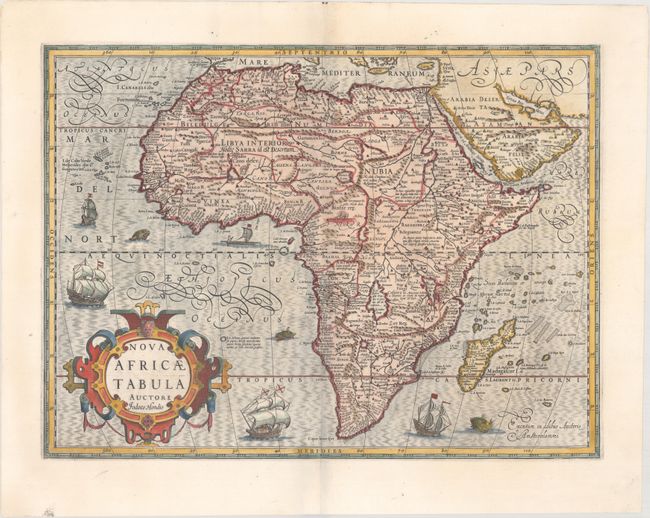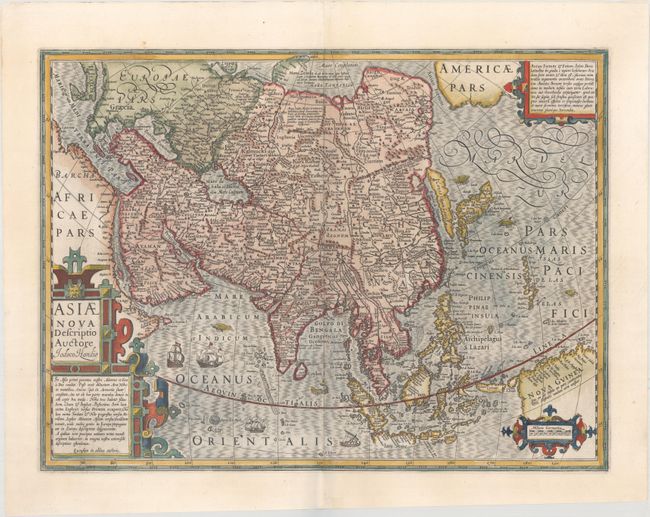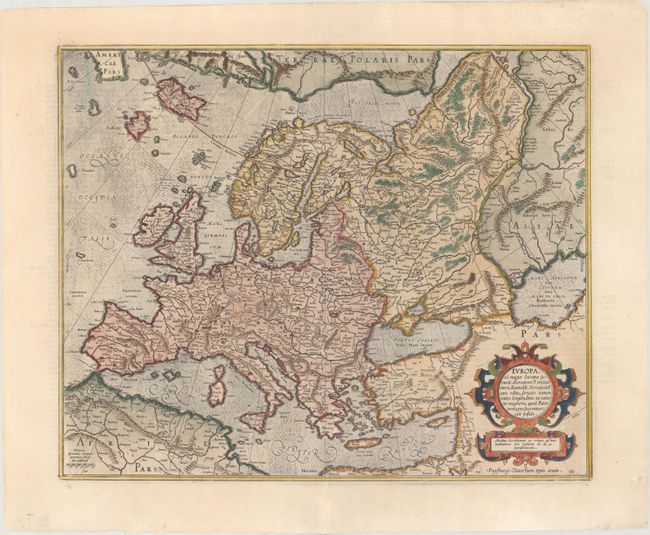Subject: World & Continents
Period: 1619 (published)
Publication: Gerardi Mercatoris - Atlas sive Cosmographicae
Color: Hand Color
This is a handsome matching set of world continents from a French edition of Mercator's Atlas, published in 1619. This set includes:
A. Orbis Terrae Compendiosa Descriptio quam ex Magna Universali Gerardi Mercatoris Domino Richardo Gartho..., dated 1587 (20.7 x 11.3"). An elaborate strapwork border surrounds this beautiful double-hemisphere map, and an armillary sphere and 32-point compass rose are tucked between the hemispheres. Rumold Mercator based this map on his father's great world map of 1569. The North Pole is depicted as a landmass surrounding a sea from which four rivers radiate and there is a well depicted Northwest Passage. The huge Terra Australis is shown as a part of Tierra del Fuego, and the lands of Lucach, Maletur and Beach (from the travel account of Marco Polo) are noted along the coast in the vicinity of present day Australia with a large island labeled Iava Minor located in the same region. Japan is shown in a kite-shaped configuration, with the fictitious Satyrorum insule (Satyr's Island) shown above. South America has a bulge on its southwest coast, and New Guinea is depicted in a large, circular configuration. The map embodies many ancient authorities and is a wonderful view of classical cartography. Cracks in the copper plate are visible in the title. References: Shirley #157; Portinaro & Knirsch XLVIII; Suarez (Veil) #31, plt. XI; Van der Krogt (Vol. I) #01:1A.
B. America (19.9 x 14.8"). Jodocus Hondius' map of the Americas is one of the most elaborate examples of fine Dutch cartography. The decorations, including sea monsters, indigenous birds, native canoes and sailing vessels, are taken from De Bry's Grand Voyages. Particularly notable is the scene of natives preparing an intoxicating drink made from manioc roots, which is derived from Hans Staden's harrowing venture into Brazil. The continents are presented on a stereographic projection, which was becoming increasingly popular at the beginning on the 17th century. It presents a more correct western coastline of South America and narrows the breadth of Mexico. However, North America is still too broad and Virginia has an exaggerated coastline. Newfoundland is based on Plancius. The coastlines are fully engraved with place names. References: Burden #150; Van der Krogt (Vol. I) #9000:1B.
C. Nova Africae Tabula (19.9 x 14.8"). In 1606 Jodocus Hondius acquired the copperplates of Mercator's Atlas, to which he added thirty-seven of his own composition, and republished this enormously influential atlas. His map of Africa strongly reflects Mercator's style with the moiré style engraving to denote the oceans and large handsome cartouche of interlocking strap design. It is also geographically based on Mercator with updates from many sources including Pigafetta, Ramusio, De Barros, and Linschoten. The eastern coastline, particularly that of Madagascar, is considerably altered. Hondius improved the southern tip by inserting Saldanha Bay and Cape False and discarding Cayneca. The map is embellished with several sailing ships, sea monsters, and a large strapwork cartouche. References: Betz #52; Norwich #27; Van der Krogt (Vol. I) #8600:1B.
D. Asiae Nova Descriptio (19.9 x 14.9"). This excellent map of Asia was Hondius’ update of Mercator’s map of 1595. Though it corrected many of Mercator’s errors, the map still has many interesting early depictions. Korea is shown as a very long island. Japan is depicted on the Ortelius-Teixeria model with three principal islands. In India, the Gulf of Cambay is very exaggerated but the shape of Ceylon has been improved. The mythical Chami Lacus appears to the northeast of India. The Philippines are marked as the Philippina Insulae, as well as Archipelagus S. Lazari, Magellan’s original name for the group. The southern coastline of Java is left blank. The northern coastline of New Guinea includes many place names from Spanish expeditions, and there is a note that it is unknown if New Guinea is a part of Terra Australis. Across the Anian Fretum lies part of North America, labeled Americae Pars, with a cartouche notation concerning the searches for a Northwest Passage. The map is richly decorated with strapwork cartouches, ships, and numerous sea monsters. References: Yeo #20; Walter #24; Van der Krogt (Vol. I) #8000:1B.
E. Europa, ad Magnae Europae Gerardi Mercatoris P. Imitationem... (18.6 x 15.1"). A beautiful map in Mercator's strong engraving style with the seas filled with waves and the land dotted with tiny cities. All of Europe is depicted, as well as Americae Pars, Greenland, Iceland, a Polar landmass, along with the mythical islands of Frisland, Drogeo, and Bradain. A large strapwork title cartouche completes the sheet. References: Van der Krogt (Vol. I) #1000:1A.
References: See description.
Condition: A
Excellent impressions on clean, bright sheets with professionally repaired centerfold separations at the bottom of each sheet, only entering the image on the maps of the Americas and Europe about 1.5" on each. The map of Europe also has archival repairs to several short tears and one large chip, all confined to the blank margins.


